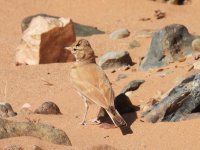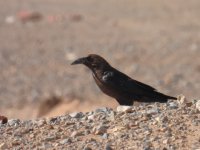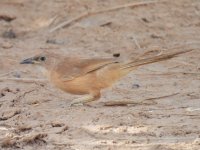sbradfield
Well-known member
Trip Report Morocco May 2024
Participants: - Simon Bradfield, Simon Hitchen, Dave Rose, guided by Hamid, assisted by Mohammad
The logistics/TripAdvisor bits -you can skip this if you just want to read about the birds.
This was effectively an 8 night/7 day trip although the first day was taken up with flying (leaving UK c 1pm arriving at 4pm). This trip involved a lot of driving and we hadn’t really this. I partly blame the Mercator effect which makes countries closer to the equator look smaller compared to more Northern countries. In particular the decision to go to the coast for Bald Ibis, rather than the High Atlas probably added at least two days driving.
Flights
Direct flights with easyJet from Gatwick and Manchester to Marrakesh. All on time and hassle free. A dishonourable mention to British Airways, who we had originally all booked to fly from Heathrow to Marrakesh. BA changed the flight time of the out going flight meaning that it no longer worked for Simon getting from Manchester to Heathrow and completely cancelled the return flight, putting us all on a return fight to Gatwick instead and telling us we would have to make our own way back to Heathrow. After some tribulations we were able to cancel without penalty and rebook with easyJet.
Accommodation in Morocco
We stayed in 6 different locations.
Palais Al Bahja, Marrakesh. A pretty standard hotel near the airport. Fit for purpose.
Riad Dades Birds, Boulmane Dades. Really nice place to stay with a lot of atmosphere, great food and good birding right on the door step.
Auberge Dunes D’Or, Merzouga. This was the only place we spent more than 1 night. A characterful if somewhat basic hotel with enormous rooms. Space is not at a premium in the desert!
Les Jardins de Ouarzazte, Ouarzazate. Straight forward tourist hotel but very pleasant, good food, nice looking pool and some gardens which had some good birds.
Apartments, Sidi Wassay. Basic self-catering type accommodation (although they did provide a meal for us). Slightly odd room layouts with sink in a different room to the toilet/shower
Hotel Aferni, Agadir. Standard resort hotel. Nice enough but nothing special.
In all hotels the staff were really friendly and had free Wi-Fi throughout.
Itinerary and Guiding
We booked with Gayuin direct in Morocco. Brahim from Gayuin arranged everything and was helpful in changing things when BA cancelled our original flight.
Our guide on the ground was Hamid, who was assisted by his younger brother Mohammad who was learning the ropes. Both were great company and Hamid certainly knew his birds.
Day 1 Sunday 12-05-24
A day of travel. We got to Marrakesh on time and having eventually cleared a slow immigration queue, found a café in the terminal to wait for Simon who was arriving on a later flight from Manchester. There, inside the terminal, we had our first bird of the trip. A House Bunting was heard singing and then spotted on a perch in the wall. This was our only bird of the day but a lifer nonetheless. We encountered them most days around human habitation.
Once Simon arrived we met up with our guide, Hamid and his brother Mohammad who was being trained. It was dark by now so we headed straight to our Marrakesh hotel. There our hopes of a beer in the hotel bar were dashed, with alcohol needing to be purchased from special shops. Future days often included a quick stop to pick up beers which the hotels were happy to put in a fridge for us and let us drink with our evening meal.
Day 2 Monday 13-05-24
Birding at the urban hotel over breakfast yielded the usual suspects. The most interesting being the large number of swifts which included both Common Swift and Pallid Swift in the sort of numbers we rarely see in the UK now and a single Little Swift. Breakfast in Morocco was not a culinary strong point anywhere we stayed consisting of fairly dry pastries, hard boiled eggs and green tea.
We set out on the long drive to Boulmane Dades. First stopping a couple of times on the outskirts of Marrakesh for some interesting birds. A Great Grey Shrike was found in a patch of scrub, the only one we saw until the last day. A pull in at a petrol station got us good views of Maghreb Magpie, a fairly recent split from Eurasian Magpie, differentiated by a patch of electric blue skin behind the eye. Our final stop was for a Little Owl, a species we encountered everywhere.
Leaving Marrakesh behind we climbed through the foothills of the Atlas. We made a brief stop to photograph a roadside European Roller just before the town of Toufliht, shortly after which we stopped at a café for a break and a welcome drink and ice cream. We spent some time on the café terrace. There we encountered African Blue Tit (a bit like a European Blue Tit that had been over-processed in Photoshop), African Chaffinch (the male being a very distinctive bird, with a paler pink breast, green back and black patch around the bill) and, perhaps less excitingly, the only Great Tit of the trip.
Shortly after our break we pulled off the road again and began to explore a scrubby gorge. A singing European Serin, was added to the list, the first of many. A Tristram’s Warbler could be heard distantly singing and we headed off in search of it. After some patient searching the bird showed quite well a couple of times but not enough to get a camera on it. In complete contrast was a male Moussier’s Redstart which was anything but camera shy. This was a bird I recall first seeing a photo of as a teenager in the 80s in an early edition of “Birdwatching” magazine. It had only taken 35 off years but I finally had gotten to Morocco and added one to my life list.
Travelling on we stopped for a good lunch at a roadside restaurant in Targa. A stunning Woodchat Shrike was perched in a bush by our table and kept us entertained throughout lunch. African Chaffinches and Common Bulbuls were plentiful here and a Eurasian Hoopoe flew into the scrubby field that the restaurant overlooked.
Travelling on we stopped again near Tabourahte for the first of the many Larks we were targeting. We soon found several “Maghreb Larks”, this is currently treated as a subspecies of Crested Lark by most authorities but is a potential future split. The most obvious difference is a stonking great bill which is immediately noticeable and much bigger than those on European birds or the Crested Larks we saw later near the coast. Hopefully a future “armchair tick”.
The next stop was at another cultivated area to look at a very smart, White-crowned Wheatear which was using an outbuilding as a useful perch. Further scanning of the area revealed several Desert Larks, feeding in the weedy patches. These blended in well with the background. The yellow based bill was the most useful ID feature on these otherwise quite plain birds. A pair of Trumpeter Finches flew in to feed. Surprisingly this was the only encounter we had with this species on the trip, whereas the Wheatear and Larks were frequently encountered.
We moved on through the valley of the roses with its roadside rose sellers and roundabouts adorned by giant rose bowls until we reached Boulmane Dades and our accommodation for the night Riad Dades Birds. This was the nicest accommodation we had in Morocco. Rooms decorated in Berber style around a beautiful courtyard. It was surrounded by farmland, so we took a pre-dinner walk, adding European Turtle-Dove, Common Nightingale and Spotted Flycatcher to our trip list. Nightingales were particularly common and often showed well here. Dinner was a superb Lamb meatball tagine.
Participants: - Simon Bradfield, Simon Hitchen, Dave Rose, guided by Hamid, assisted by Mohammad
The logistics/TripAdvisor bits -you can skip this if you just want to read about the birds.
This was effectively an 8 night/7 day trip although the first day was taken up with flying (leaving UK c 1pm arriving at 4pm). This trip involved a lot of driving and we hadn’t really this. I partly blame the Mercator effect which makes countries closer to the equator look smaller compared to more Northern countries. In particular the decision to go to the coast for Bald Ibis, rather than the High Atlas probably added at least two days driving.
Flights
Direct flights with easyJet from Gatwick and Manchester to Marrakesh. All on time and hassle free. A dishonourable mention to British Airways, who we had originally all booked to fly from Heathrow to Marrakesh. BA changed the flight time of the out going flight meaning that it no longer worked for Simon getting from Manchester to Heathrow and completely cancelled the return flight, putting us all on a return fight to Gatwick instead and telling us we would have to make our own way back to Heathrow. After some tribulations we were able to cancel without penalty and rebook with easyJet.
Accommodation in Morocco
We stayed in 6 different locations.
Palais Al Bahja, Marrakesh. A pretty standard hotel near the airport. Fit for purpose.
Riad Dades Birds, Boulmane Dades. Really nice place to stay with a lot of atmosphere, great food and good birding right on the door step.
Auberge Dunes D’Or, Merzouga. This was the only place we spent more than 1 night. A characterful if somewhat basic hotel with enormous rooms. Space is not at a premium in the desert!
Les Jardins de Ouarzazte, Ouarzazate. Straight forward tourist hotel but very pleasant, good food, nice looking pool and some gardens which had some good birds.
Apartments, Sidi Wassay. Basic self-catering type accommodation (although they did provide a meal for us). Slightly odd room layouts with sink in a different room to the toilet/shower
Hotel Aferni, Agadir. Standard resort hotel. Nice enough but nothing special.
In all hotels the staff were really friendly and had free Wi-Fi throughout.
Itinerary and Guiding
We booked with Gayuin direct in Morocco. Brahim from Gayuin arranged everything and was helpful in changing things when BA cancelled our original flight.
Our guide on the ground was Hamid, who was assisted by his younger brother Mohammad who was learning the ropes. Both were great company and Hamid certainly knew his birds.
Day 1 Sunday 12-05-24
A day of travel. We got to Marrakesh on time and having eventually cleared a slow immigration queue, found a café in the terminal to wait for Simon who was arriving on a later flight from Manchester. There, inside the terminal, we had our first bird of the trip. A House Bunting was heard singing and then spotted on a perch in the wall. This was our only bird of the day but a lifer nonetheless. We encountered them most days around human habitation.
Once Simon arrived we met up with our guide, Hamid and his brother Mohammad who was being trained. It was dark by now so we headed straight to our Marrakesh hotel. There our hopes of a beer in the hotel bar were dashed, with alcohol needing to be purchased from special shops. Future days often included a quick stop to pick up beers which the hotels were happy to put in a fridge for us and let us drink with our evening meal.
Day 2 Monday 13-05-24
Birding at the urban hotel over breakfast yielded the usual suspects. The most interesting being the large number of swifts which included both Common Swift and Pallid Swift in the sort of numbers we rarely see in the UK now and a single Little Swift. Breakfast in Morocco was not a culinary strong point anywhere we stayed consisting of fairly dry pastries, hard boiled eggs and green tea.
We set out on the long drive to Boulmane Dades. First stopping a couple of times on the outskirts of Marrakesh for some interesting birds. A Great Grey Shrike was found in a patch of scrub, the only one we saw until the last day. A pull in at a petrol station got us good views of Maghreb Magpie, a fairly recent split from Eurasian Magpie, differentiated by a patch of electric blue skin behind the eye. Our final stop was for a Little Owl, a species we encountered everywhere.
Leaving Marrakesh behind we climbed through the foothills of the Atlas. We made a brief stop to photograph a roadside European Roller just before the town of Toufliht, shortly after which we stopped at a café for a break and a welcome drink and ice cream. We spent some time on the café terrace. There we encountered African Blue Tit (a bit like a European Blue Tit that had been over-processed in Photoshop), African Chaffinch (the male being a very distinctive bird, with a paler pink breast, green back and black patch around the bill) and, perhaps less excitingly, the only Great Tit of the trip.
Shortly after our break we pulled off the road again and began to explore a scrubby gorge. A singing European Serin, was added to the list, the first of many. A Tristram’s Warbler could be heard distantly singing and we headed off in search of it. After some patient searching the bird showed quite well a couple of times but not enough to get a camera on it. In complete contrast was a male Moussier’s Redstart which was anything but camera shy. This was a bird I recall first seeing a photo of as a teenager in the 80s in an early edition of “Birdwatching” magazine. It had only taken 35 off years but I finally had gotten to Morocco and added one to my life list.
Travelling on we stopped for a good lunch at a roadside restaurant in Targa. A stunning Woodchat Shrike was perched in a bush by our table and kept us entertained throughout lunch. African Chaffinches and Common Bulbuls were plentiful here and a Eurasian Hoopoe flew into the scrubby field that the restaurant overlooked.
Travelling on we stopped again near Tabourahte for the first of the many Larks we were targeting. We soon found several “Maghreb Larks”, this is currently treated as a subspecies of Crested Lark by most authorities but is a potential future split. The most obvious difference is a stonking great bill which is immediately noticeable and much bigger than those on European birds or the Crested Larks we saw later near the coast. Hopefully a future “armchair tick”.
The next stop was at another cultivated area to look at a very smart, White-crowned Wheatear which was using an outbuilding as a useful perch. Further scanning of the area revealed several Desert Larks, feeding in the weedy patches. These blended in well with the background. The yellow based bill was the most useful ID feature on these otherwise quite plain birds. A pair of Trumpeter Finches flew in to feed. Surprisingly this was the only encounter we had with this species on the trip, whereas the Wheatear and Larks were frequently encountered.
We moved on through the valley of the roses with its roadside rose sellers and roundabouts adorned by giant rose bowls until we reached Boulmane Dades and our accommodation for the night Riad Dades Birds. This was the nicest accommodation we had in Morocco. Rooms decorated in Berber style around a beautiful courtyard. It was surrounded by farmland, so we took a pre-dinner walk, adding European Turtle-Dove, Common Nightingale and Spotted Flycatcher to our trip list. Nightingales were particularly common and often showed well here. Dinner was a superb Lamb meatball tagine.






































